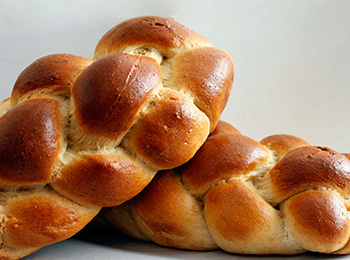This past July, I spent a wonderful afternoon with several of my friends at a challah baking class. Challah is Jewish soul food. Baking challah is a mitzvah, a real connection to yourself, your community, your family and the Jewish People.
Gail Michalowicz was invited to teach us to how to make a delicious challah recipe. We also had the privilege of learning from her many of the traditions and meanings for making challah, as well as all the steps and prayers involved along the way. Michalowicz is very involved in the community-wide “Generation to Generation” challah bake of 2,000 women and girls planned for Oct. 23 and 24. She urges that Jewish women in our community should consider being a part of it.
At the beginning of our lesson, we were each supplied with a disposable apron, a bowl and a spatula. All the ingredients were laid out on the table and we went to work. Michalowicz explained to us that as we put the challah ingredients together in the bowl, it is an opportune time for prayer and reflection. With the addition of each ingredient, we think of the deeper significance and meaning behind its physical reality. We learned that:
The Bowl: Represents the home, and each additional ingredient should bring its unique blessing.
Flour: Represents the raw material we desperately need for substance.
Sugar: As we pour in the sugar we hope and pray for a life that is a “Ma Tov U’Ma Nayim” or has sweetness and good things.
Salt: We hide the salt in the flour to remind ourselves not to be overly critical, and also to accept the sting of criticism from others.
Yeast: Represents the understanding to keep growing and expanding.
Water: Represents a life of clarity and wisdom. For the Torah, our instruction book to living, is called “Mayim Chayim” or the water of life.
Oil: Represents abundance and blessing. Jewish kings were anointed with oil for blessing and understanding. As we pour the oil into the bowl, we think of anointing each member of our family with blessing and understanding. Surprisingly, we learned that we start with ourselves, as we are the heart of the home.
Eggs: Represent fertility and the cycle of life because of their shape. We pray for the strength to travel the cycles of life and for fertility.
Last, we take all of these varied ingredients and knead them together into an exquisite challah dough. This symbolizes that we need to take all the different people and relationships in our lives and knead them into a beautiful unit and community.
We learned that when making dough with more than 12-1/2 cups of flour, an olive size portion of dough is removed that is actually called “challah,” and a special brachah or prayer is said. This is done to remember the mitzvah of challah as prescribed in the Torah. This piece of challah was given to the kohen, thereby showing appreciation and reinforcing trust in HaShem.
Michalowicz also showed us how to make a braided bun, a loaf challah and a braided challah. We were sent home with our challah dough to let it rise for the last time and bake it in our own homes as is the tradition. I made my dough into cute little buns and the aroma wafting from the oven made my house smell wonderful.
Challah recipe
o 1 tbsp. salt
o 7 cups flour, starting with 6 1/2
o 3/4 cup sugar
o 1 1/2 tbsp. instant dry yeast
o 2 cups warm water
o 2 eggs
o 1/2 cup oil (plus a bit extra for oiling the dough)
In a large bowl combine all the dry ingredients: flour, yeast, salt and sugar. Add the warm water, oil and eggs and mix to make a soft dough. Knead the dough for 10 to 15 minutes. Oil the dough and cover the bowl. Let dough rise until doubled, approximately 45 minutes to 1 hour. Punch down and shape. Let rise an additional 45 minutes.
Heat oven to 350. On a floured board, shape or braid challah, as desired, and place on cookie sheet covered with parchment paper. Bake for 30 to 45 minutes depending on the size, until golden brown. Challah is baked when it sounds hollow when tapped.
